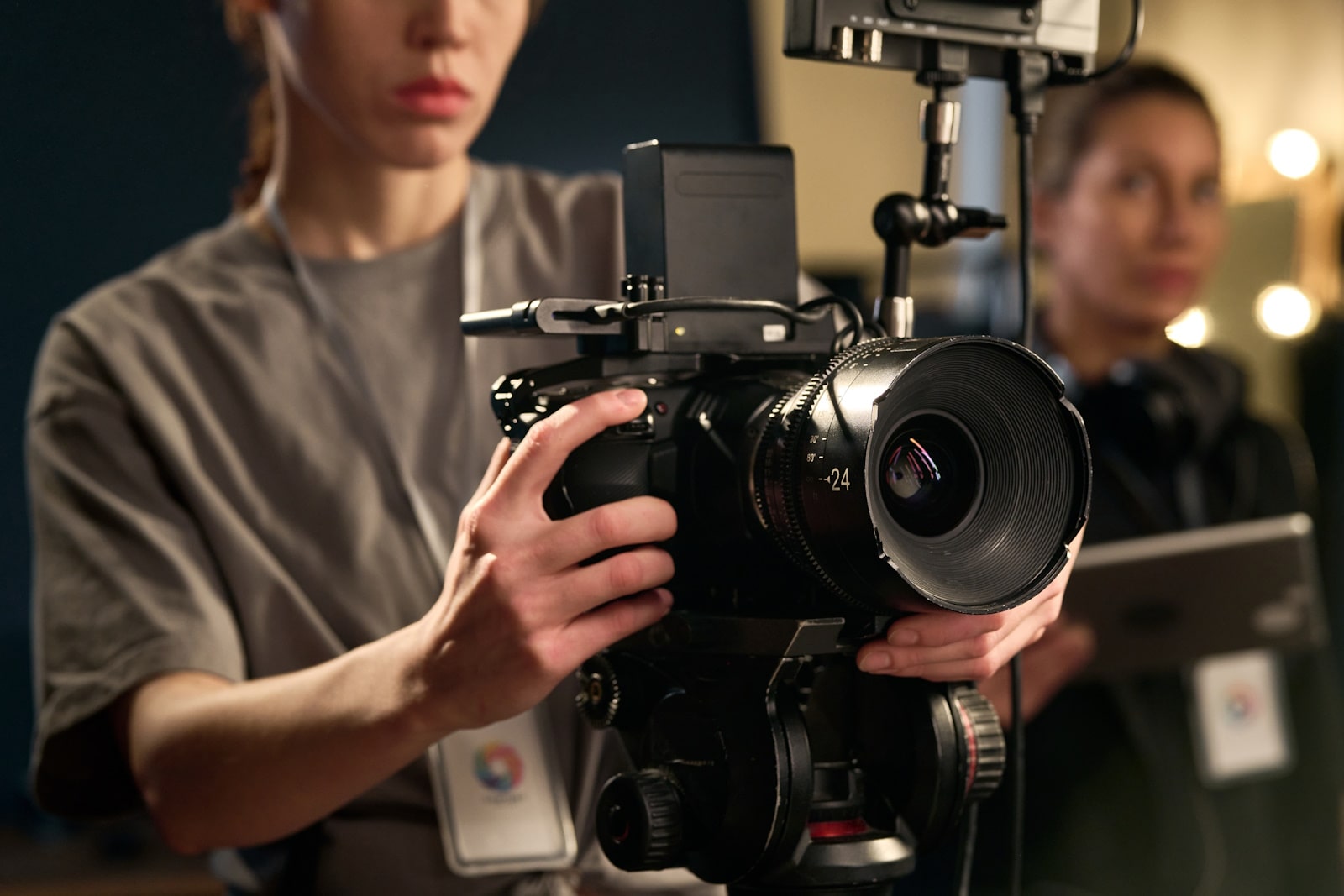
The Role of Cinematography in a Video Production Company
Cinematography is at the heart of powerful visual storytelling. It elevates ideas beyond the script, using light, colour, camera movement, and composition to create meaning and emotion. For any video production company, mastering cinematography is essential to transform concepts into immersive experiences that resonate with audiences on a visceral level.
Visual Composition: Framing the Focus
Visual composition is the art of arranging elements within a frame to guide the viewer’s focus and convey narrative meaning. By using techniques like the rule of thirds, leading lines, and balanced symmetry, a video production company ensures that the subject is positioned to maximise emotional and narrative impact. Strategic framing can depict vulnerability through central isolation or power through upward angles, reinforcing the psychological state of characters without the need for dialogue.
Beyond aesthetics, framing determines storytelling clarity. Directors and cinematographers design compositions that reveal relationships between characters and their environments. For example, a wide composition can emphasise a character’s loneliness within an expansive setting, while tight framing can evoke claustrophobia or intimacy. Effective visual composition shapes how a story is experienced, positioning the viewer exactly where the filmmaker intends.
Lighting Techniques: Mood Through Illumination
Lighting is more than visibility; it is the sculptor of emotion and mood in storytelling. Soft, diffused lighting creates warmth and intimacy, while hard, directional lighting evokes tension and mystery. For a video production company, manipulating shadows and highlights is a powerful way to shape perceptions of character and atmosphere within each scene.
Lighting design also affects realism and stylisation. Naturalistic lighting immerses viewers in believable worlds, whereas stylised lighting heightens drama or symbolism. Cinematographers use tools like negative fill to increase contrast and bounce lighting to soften shadows, crafting scenes that evoke specific psychological responses. Understanding lighting fundamentals empowers a video production company to create productions that not only look visually stunning but also communicate meaning at a subconscious level.
Camera Movement: Panning, Tilting, Tracking
Camera movement brings rhythm and energy to visual storytelling. Whether it is a slow pan revealing a tranquil landscape or a dynamic tracking shot following a character in motion, each movement influences narrative pacing and emotional engagement. A video production company leverages camera moves to immerse viewers, build anticipation, or reveal important visual information gradually.
Beyond aesthetics, camera movement guides emotional interpretation. For instance, a steady tracking shot can convey confidence and calm, while handheld movement might add urgency or realism to intense scenes. The psychology of movement shapes narrative perception, allowing cinematographers to synchronise camera kinetics with character journeys and thematic arcs, enriching the storytelling experience for the viewer.
Colour Palette: Tone Reinforcement
Colour is a powerful storytelling device that influences mood, symbolism, and narrative cohesion. Warm palettes such as reds and oranges evoke passion, nostalgia, or comfort, while cool tones like blue and teal create tension, melancholy, or detachment. A video production company uses colour grading to reinforce themes and ensure visual continuity across scenes.
The deliberate use of complementary or analogous colour schemes strengthens aesthetic harmony, guiding emotional responses intuitively. For example, desaturated colours can evoke bleakness or realism, whereas vibrant hues might suggest fantasy or heightened reality. Thoughtful colour palette design deepens the narrative impact, ensuring viewers subconsciously interpret scenes in line with story objectives.
Lens Choice: Shaping Perception
Lens choice is fundamental to storytelling because it shapes spatial relationships, depth, and viewer perception. Wide-angle lenses expand the field of view, enhancing a sense of scale or environment, while telephoto lenses compress distance, creating intimacy by visually isolating subjects from their background. A video production company selects lenses based on emotional and narrative requirements of each scene.
Macro lenses can be used to reveal intricate details that are otherwise overlooked, highlighting objects with symbolic meaning. Different focal lengths also influence visual style—wide lenses create distortion and dynamic perspectives, while longer lenses provide a flatter, more naturalistic representation. The ability to select the appropriate lens empowers cinematographers to control not just what is seen but how it is emotionally received by the audience.
Depth of Field: Spotlighting the Subject
Depth of field refers to the extent of focus within an image, and controlling it is crucial in directing viewer attention. A shallow depth of field blurs the background, isolating the subject and creating an intimate focus, while deep focus retains detail in both foreground and background, situating characters within their environment. A video production company leverages this technique to prioritise story elements visually.
The psychological impact is significant. Selective focus evokes subjectivity, placing viewers within a character’s perspective, whereas deep focus invites interpretation of complex scenes with multiple active elements. Mastery of depth of field transforms cinematography from mere recording to purposeful storytelling.
Shot Size and Scale
Shot size and scale communicate narrative information non-verbally. Extreme close-ups capture minute expressions, conveying vulnerability or intensity, while wide shots establish location, context, and isolation or grandeur. A video production company uses variations in shot scale to manipulate emotional proximity between viewer and subject.
Medium shots balance environmental context with character focus, often used for dialogue to maintain intimacy without sacrificing spatial awareness. Thoughtful sequencing of different shot sizes creates rhythm, enhances pacing, and supports the emotional arc of a scene, enriching the viewer’s journey through nuanced visual language.
Use of Perspective: Angles That Speak
Perspective shapes how viewers relate to characters and narrative situations. High angles diminish characters, suggesting vulnerability or insignificance, while low angles confer power, dominance, or heroism. Point-of-view shots immerse audiences directly within a character’s experience, enhancing empathy and understanding. A video production company employs perspective to shape narrative tone and viewer alignment with characters.
Creative use of Dutch angles (tilted frames) can disorient viewers to reflect psychological instability or tension within the story world. By mastering perspective techniques, cinematographers can guide subconscious interpretations that enrich narrative layers and emotional engagement.
Visual Symbolism: Metaphors and Motifs
Visual symbolism incorporates deeper meaning through cinematography. Objects, colours, or framing choices become recurring motifs, creating layers of meaning beyond dialogue. For example, shadows can symbolise moral ambiguity, while recurring doorways may signify transition or choice. A video production company integrates these elements purposefully to craft rich, multi-layered visual narratives.
Symbolism anchors thematic coherence, guiding viewers towards deeper understanding of the story’s message. Even simple visual metaphors, when intentionally placed, can transform a straightforward narrative into a powerful cinematic experience.
Lighting Colour Temperature: Warm vs Cool
Lighting colour temperature influences psychological perception within scenes. Warm lighting feels inviting, intimate, or nostalgic, while cool lighting creates detachment, unease, or calmness. A video production company manipulates colour temperature to support emotional shifts and narrative intention seamlessly within a production.
Subtle temperature shifts can indicate a character’s mental state or signal upcoming tonal changes in the storyline. Understanding how viewers perceive these temperatures allows cinematographers to communicate moods and transitions intuitively, deepening the storytelling experience with visual sophistication.
At Sound Idea Digital, we combine creative expertise and technical precision to craft cinematography that makes stories unforgettable. If you want your production to resonate with audiences and stand apart from competitors, contact us today. Let our video production company bring your vision to life with impactful visual storytelling.



